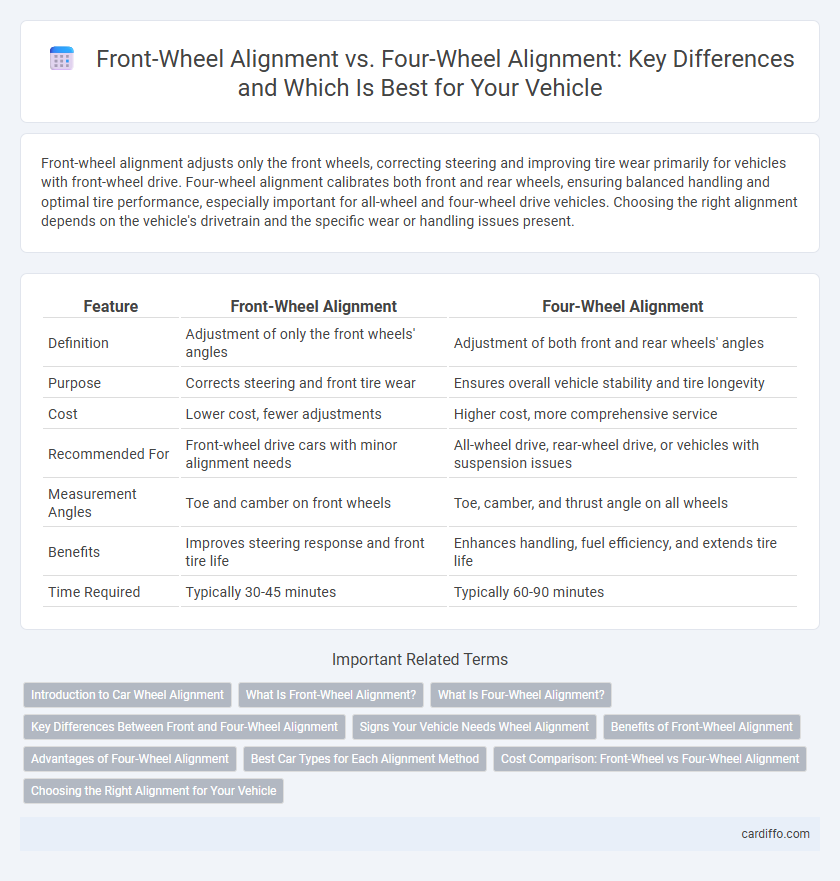Front-wheel alignment adjusts only the front wheels, correcting steering and improving tire wear primarily for vehicles with front-wheel drive. Four-wheel alignment calibrates both front and rear wheels, ensuring balanced handling and optimal tire performance, especially important for all-wheel and four-wheel drive vehicles. Choosing the right alignment depends on the vehicle's drivetrain and the specific wear or handling issues present.
Table of Comparison
| Feature | Front-Wheel Alignment | Four-Wheel Alignment |
|---|---|---|
| Definition | Adjustment of only the front wheels' angles | Adjustment of both front and rear wheels' angles |
| Purpose | Corrects steering and front tire wear | Ensures overall vehicle stability and tire longevity |
| Cost | Lower cost, fewer adjustments | Higher cost, more comprehensive service |
| Recommended For | Front-wheel drive cars with minor alignment needs | All-wheel drive, rear-wheel drive, or vehicles with suspension issues |
| Measurement Angles | Toe and camber on front wheels | Toe, camber, and thrust angle on all wheels |
| Benefits | Improves steering response and front tire life | Enhances handling, fuel efficiency, and extends tire life |
| Time Required | Typically 30-45 minutes | Typically 60-90 minutes |
Introduction to Car Wheel Alignment
Car wheel alignment ensures proper angles of the wheels relative to each other and the road surface, optimizing tire performance and vehicle handling. Front-wheel alignment adjusts only the front wheels' camber, caster, and toe angles, suitable for vehicles with front-wheel drive. Four-wheel alignment calibrates all wheels for precise alignment, critical for all-wheel-drive cars or vehicles with independent rear suspension.
What Is Front-Wheel Alignment?
Front-wheel alignment specifically adjusts the angles of the front wheels to ensure proper steering and tire wear, focusing on parameters like camber, caster, and toe. This type of alignment addresses misalignment issues caused by impacts or suspension wear primarily affecting the front axle. Front-wheel alignment is crucial for vehicles where the front wheels handle most of the steering and braking forces, ensuring optimal handling and safety.
What Is Four-Wheel Alignment?
Four-wheel alignment adjusts all four wheels to ensure optimal tire contact and vehicle handling, improving stability and extending tire life. Unlike front-wheel alignment, which only corrects the front wheels, four-wheel alignment addresses the rear wheels' camber, caster, and toe angles as well. This comprehensive approach is essential for vehicles with independent rear suspension or all-wheel drive systems, promoting balanced traction and even tire wear.
Key Differences Between Front and Four-Wheel Alignment
Front-wheel alignment adjusts only the angles of the front wheels, primarily focusing on camber, caster, and toe to ensure proper steering and tire wear. Four-wheel alignment involves aligning all four wheels, correcting the rear wheels in addition to the front, which is essential for vehicles with independent rear suspension or all-wheel drive systems. The key difference lies in the scope and precision; four-wheel alignment provides more comprehensive handling and stability improvements, especially for performance and safety on varied road conditions.
Signs Your Vehicle Needs Wheel Alignment
Uneven tire wear, such as bald spots on front tires, often indicates the need for front-wheel alignment. If the vehicle pulls to one side or the steering wheel vibrates, these symptoms suggest misalignment affecting all wheels, making four-wheel alignment necessary. Regular inspections every 6,000 to 8,000 miles help detect alignment issues early, preserving tire performance and vehicle safety.
Benefits of Front-Wheel Alignment
Front-wheel alignment targets the adjustment of the front wheels, enhancing steering precision and tire lifespan by ensuring optimal contact with the road. This method is cost-effective and quicker compared to four-wheel alignment, making it ideal for vehicles prone to front-end wear or those primarily used in urban settings. Regular front-wheel alignment reduces uneven tire wear, improves fuel efficiency, and ensures safer handling in everyday driving conditions.
Advantages of Four-Wheel Alignment
Four-wheel alignment ensures precise adjustment of all tires, enhancing overall vehicle stability and reducing uneven tire wear compared to front-wheel alignment. This comprehensive approach improves handling and safety by correcting camber, caster, and toe angles on both front and rear wheels. Vehicles with advanced suspension systems particularly benefit from four-wheel alignment, extending tire lifespan and optimizing fuel efficiency.
Best Car Types for Each Alignment Method
Front-wheel alignment is ideal for vehicles with front-wheel drive systems, such as compact cars and small SUVs, where only the front wheels are responsible for steering and power delivery. Four-wheel alignment is best suited for all-wheel-drive, rear-wheel-drive, and performance vehicles, including luxury sedans and trucks, ensuring precise adjustment of both front and rear wheels for optimal handling and tire longevity. Choosing the correct alignment method based on drivetrain and vehicle type enhances stability, tire wear, and overall driving safety.
Cost Comparison: Front-Wheel vs Four-Wheel Alignment
Front-wheel alignment typically costs between $50 to $75, as it involves adjusting only the front wheels, which affects steering and tire wear. Four-wheel alignment ranges from $100 to $150 due to the comprehensive adjustment of all wheels, ensuring optimal handling and even tire wear across both front and rear axles. Choosing the appropriate alignment depends on the vehicle's drivetrain and suspension design, impacting overall maintenance costs.
Choosing the Right Alignment for Your Vehicle
Choosing the right alignment depends on your vehicle's drivetrain and specific handling needs, with front-wheel alignment typically recommended for front-wheel-drive cars to correct toe and camber angles on the front tires. Four-wheel alignment is essential for all-wheel-drive and rear-wheel-drive vehicles, ensuring precise adjustment of all wheels to enhance overall stability, tire performance, and steering response. Proper alignment improves tire longevity, fuel efficiency, and safety, making it crucial to consult a certified technician to determine the best service based on your vehicle model and driving habits.
Front-Wheel Alignment vs Four-Wheel Alignment Infographic

 cardiffo.com
cardiffo.com